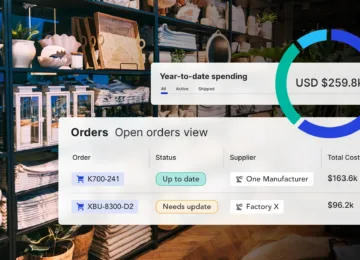As a manufacturing leader, the last thing you want to do is send out an inaccurate or fraudulent invoice to your customers and clients. At the same time, you want to avoid the hassle of tracking down late payments while ensuring that your accounts payable and finance departments can do their jobs quickly and accurately. Having a system can help you avoid submitting fraudulent invoices and keep your accounts payable flowing.
Three-way matching is a way to safeguard your accounts and avoid sending out inaccurate invoices. In this article, we’ll go over what a three-way match is, how you can perform three-way matching in your manufacturing business, why it’s beneficial to your organization, and how automating three-way matching can improve your payment processes.
3-Way Matching: The Key to Accounts Payable
Three-way matching is a process that compares three different documents: the purchase order (also called the PO), the order receipt or packing slip, and the invoice. By ensuring that these pieces of information all match, the supplier invoice is submitted. It helps to avoid errors or incorrect payments by having two different sources of truth to back up each invoice.
The most important part of three-way matching is the three main components used in the process. Those are:
- Purchase Orders (PO): Purchase orders are the documents that list the types, amounts, and prices of the brand’s products and services.
- Order Receipts & Packing Slips: Order receipts and packing slips are the receiving reports of payment that accompany shipments of goods, typically within a distribution center. These detail exactly what is included in each shipment line item by line item.
- Invoices: The supplier invoice is the document that states what amount is owed for goods and services delivered. It includes the invoice number, PO number, early payment discounts and other discounts, supplier names and information, payment schedules, and the total amount owed.
With multiple parties involved in this process, it’s critical for all this information to be aligned to ensure accuracy and consistency.
What Is the Difference Between a 3-Way Match and a 2-Way Match?
Most businesses currently run their invoicing with two-way matching. Rather than verifying three different pieces of information, the company would only check the invoice against the purchase order. However, an issue arises if the purchase order doesn’t accurately reflect what was delivered and recorded on the packing slip.
By adding the third level of verification with the order receipt, you can ensure that you are billing for what your customers actually received, not just what order they placed. This keeps everything compliant and helps companies ensure they’ve successfully delivered everything that a customer ordered.
Breakout: What About 4-Way Matching?
Another type of match is the four-way match. Four-way matching takes three-way matching a step further and includes the inspection and verification of delivered goods. All the products are carefully examined and verified before the shipment is accepted, ensuring that there are no damages or issues with the delivery itself.
While this is a critical step in businesses or industries where strict compliance or verification laws are in place, it’s a meticulous and time-consuming process, making it unreasonable for most billing and invoicing purposes. Three-way matching is the best, most accurate method of avoiding fraudulent invoices and keeping payment processes moving smoothly.
How To Perform a 3-Way Match
To perform a three-way match, you first need to collect the three pieces of documentation that you will check against each other. When a buyer places an order with a supplier, a PO is created and the accounting department or payable department creates an invoice based on that PO. The invoice is then sent to the buyer, and the supplier then checks that invoice and PO against the packing slip. If the three documents match and the order is verified, the invoice is released and payment is accepted.
If the documents don’t match, the supplier places a hold on the invoice until the issue is reconciled and the order is verified. Once verified, the invoice is released and any pending payments are accepted.
Case Study: Purchasing Semiconductors from a Vendor
Now we can take the process of a three-way match and put it into perspective with a case study. Let’s say that a buyer decides to purchase 10 semiconductors from a supplier. First, they place the order and the PO is sent to the supplier. Once the payable team receives the PO, they create an invoice for $6,000 based on that PO.
Once the order is shipped to the buyer, the receiving department will check the packing slip against the purchase order to see if there are any discrepancies. If all 10 semiconductors are accounted for, then the final invoicing approval process can begin. The semiconductor vendor will send the invoice to the buyer and release the invoice to be paid (once the order is verified).
If there is a mistake and only nine semiconductors are delivered, the invoice will hold and the payment will stay pending until the issue is resolved and all three documents are in agreement about the shipment and cost of goods.
The Benefits of Performing 3-Way Matching
Three-way matching has many benefits for businesses in industries across the globe. It helps create order accuracy by ensuring that the order receipt matches the purchase order. And because those documents are then matched against the invoice, it decreases the chances of having duplicate and erroneous payments. Other benefits include:
- Time-Saving: The three-way match is a big time saver for businesses as they don’t have to spend time resubmitting and reverifying data and information.
- Money-Saving: Three-way matching is also a money saver, as there is no need to return fraudulent or duplicate payments to buyers when invoices are incorrect.
- Supports Better Supplier-Buyer Relationships: Sending out an incorrect invoice could damage your relationship with your buyers. The verification process of three-way matching helps increase transparency and make relationships stronger.
- Makes Auditing Easy: In the case of an audit, three-way matching keeps things error-free and easy to compile if needed. Auditors will have an easier time checking through data that has been three-way matched.
Why Organizations Are Automating the 3-Way Match Process
As more and more companies understand the value and importance of three-way matching, they are also looking at ways to automate this process. By automating three-way matching, organizations can reduce the amount of time and labor that goes into verifying data and documents. Benefits of automating three-way invoicing include:
- Streamlining accounts payable procedures
- Managing large quantities of invoices
- Organizing many pieces of data or documents
- Quickly verifying POs, invoices, and order slips
- Reducing extra manual labor
- Scaling operations and procedures
While many tools can help automate invoicing, tying it into your supply chain management software can cut out additional steps and data synchronization. A single platform that handles the supply chain and invoicing keeps everything in a single location and database.
Manual Matching Is Slow, Erroneous, and Repetitive
Manually matching the documents in the three-way matching process might have been the only way to verify information in the past. But in today’s business world, it results in a slow, repetitive, and often inaccurate process. Some of the downfalls of relying on manual matching include:
- Spending more time matching by hand
- Increased costs and expenses for labor and paper
- Late payments from delays, bottlenecks, and backlogs
- Human error in processing
- Lost or missing invoices
Identify Discrepancies Between Orders, Shipments, and Invoices With Anvyl
Three-way matching is a great way to avoid discrepancies between orders, receipts, and invoices. Including a three-way matching process as part of your payment and accounts receivable processes ensures that your customers aren’t overpaying on their vendor invoices and that all documents match every line item charged. This ensures your bookkeeping is all tracked, and there are no bottlenecks from delayed payments or reissued invoices.
Anvyl’s production management system is designed with transparency and collaboration in mind, making it the perfect automation solution for AP automation. With Anvyl, you can streamline your ordering and accounts payable processes while keeping data accessible for your entire team. Learn more about our production management system and find out what Anvyl can do for your business today!



